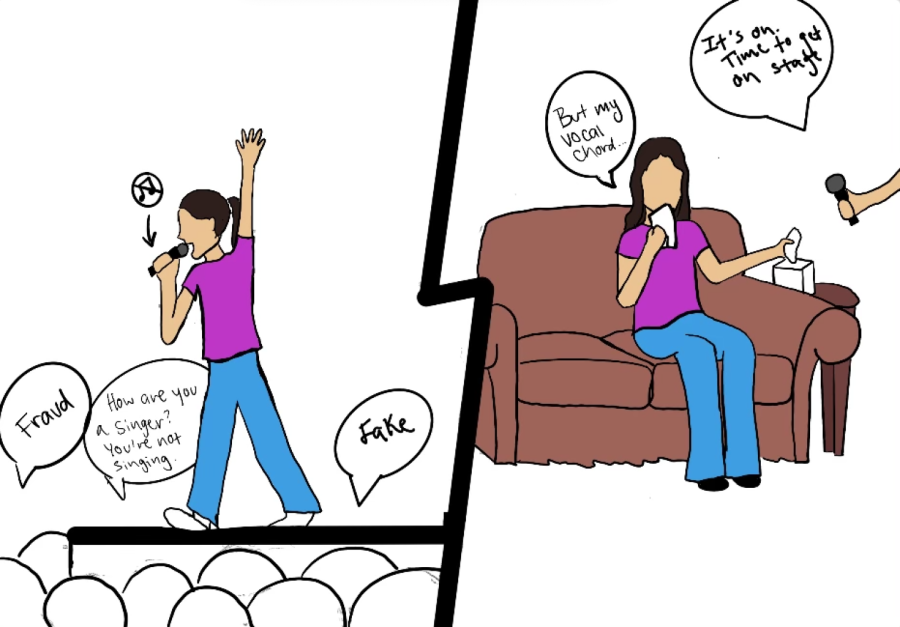The use of lip-synching in concerts is a hotly-contested topic by many people, with some arguing for its continuation due to the aid it provides artists’ health and others staunchly opposing it due to its inauthenticity.
H2H: To Synch or Not to Synch
April 18, 2023
Singers, not Synchers: Artists Should Not Rely on Prerecorded Tracks During Concerts
Fans often spend hundreds, even thousands, of dollars to secure tickets to their favorite artist’s latest concert. Ready to hear the songs they have spent months memorizing performed live onstage for the first time, fans are both shocked and disappointed to hear the artist merely mouthing along to a prerecorded track of the musician’s vocals.
This phenomenon has become a common occurrence in recent years with many singers choosing to prioritize visual performance over their own musical talents, according to British historian Ian Inglis in his book “Performance and Popular Music.”
Artists should refrain from performing to pre-recorded audio in order to maximize the value they provide fans who sacrificed both time and money to attend their concerts.
“Listening to live music is part of the concert experience,” senior Ama Loukili said. “Lip synching for a bit is okay, of course, so the performers can catch their breath, but concerts should always be majority live vocals.”
Typically, performers use lip-synching to mask perceived deficiencies in the artist’s performance; much of these perceptions may actually stem from pressure put on artists to perform a “perfect” show by the watchful eyes of the media, according to Untapped Sound.
Despite this, artists should not feel obligated to lip-synch for perfection’s sake; rather, they should allow each show to be unique and embrace mistakes they may make on stage.
Artists such as Rihanna and Billy Joel have historically invited fans up to perform with them on stage, according to VH1. On her current stadium tour, renowned pop star Taylor Swift chose to switch up the setlist by adding two “surprise” acoustic songs each night. These actions increase fan interaction and are ultimately more entertaining than lip synching.
Some may argue that it is the artist’s obligation to create the best show possible and that lip synching is the only means to perform particularly difficult numbers.
But the true merit of a concert’s validity should not be judged on the singers’ technical prowess. It should be the unique personality they develop that takes center stage instead.
At the end of the day, one fundamental element of singers’ artistry is their ability to cater to their fans, and embracing spontaneity is one of the easiest ways to achieve that. Focusing too hard on creating a technically perfect show ultimately detracts from that, upsetting fans who made dedicated efforts to see these shows.

Tara Vatandoust is an Editor-in-Chief for her third, and sadly, final year on the Portola Pilot. This year, she is looking forward to (finally!) being...
Lip-Syncing Is Not an Egregious Crime
“Mariah Carey’s Disastrous Performance on New Year’s Eve 2016.”
“Selena Gomez Slammed for 2017 AMA Performance.”
These are just two of the thousands of degrading headlines criticizing renowned vocalists for lip-syncing on stage. Instead of receiving appreciation for their spectacular performance, many talented artists face severe backlash for using a pre-recorded track rather than singing live.
Despite the numerous complaints from dissatisfied audience members, lip-syncing to a pre-recorded track during concerts allows singers to effectively meet the demands of their fans while avoiding long-term vocal cord damage. Artists are not dishonest for taking measures to protect their health and preserve their overworked voices.
Concert-goers often underestimate the detrimental effects that continuous live singing has on a performer’s voice. Hectic practice schedules coupled with extended tour performances take a toll on an artist’s voice and permanently damage fragile vocal cords.
“The strain of singing full-voiced for an hour and a half is intense — as hard on the larynx as a professional football game is on a lineman’s body,” Dr. Natasha Mirza, the director of the Center for Voice and Swallowing at the University of Pennsylvania, said in an interview with the New York Times.
Without relying on pre-recorded tracks, artists do not have sufficient time to recover between shows and must endure vocal fatigue.
Overworking the voice catalyzes the development of polyps, cysts, granulomas and nodules on their vocal folds, according to the Cleveland Clinic. These growths prevent the vocal cords from vibrating normally, causing hoarseness, vocal cracks and neck pain, according to CBS News.
As a result, acclaimed artists who are praised for their live vocals like Adele, Keith Urban and John Mayer require surgery to remove growths. Suffering from a severe case of vocal nodules, Adele underwent laser surgery for her throat and was forced to cancel shows for over half a year, according to The Guardian.
While these artists received positive responses for steering away from lip-syncing, their efforts to sing live cost them their laryngeal health and jeopardized their singing careers.
For many concert-goers who have listened to the same songs many times before, the highlight of a show is not the auditory elements, but rather the visual appeal.
Artists often incorporate choreography and precise stage blocking to keep fans entertained. Consequently, lip-syncing allows artists to maintain their high energy and engage in strenuous on-stage activities like dancing and jumping as they sing.
“I don’t know any athlete in the world who can do that for more than an hour and not become winded,” Jack Boessneck, vice president of one of the largest sound equipment rental houses Eighth Day Sound, said in an interview with the Hollywood Reporter. “That’s why there’s a simultrack [pre-recorded track] running. If an artist happens to not be able to hit the notes, that backing track helps. That’s only fair.”
Regardless of whether the performance is live or lip-synced, concert-goers should take the time to celebrate the stagecraft of the artists and enjoy the extravaganza unfolding in front of their eyes.

Madeline Chung is the Arts and Entertainment Editor for her second and final year on the Portola Pilot. When she is not complaining about how terrible...

